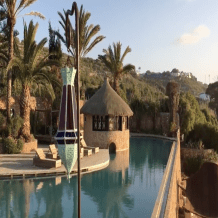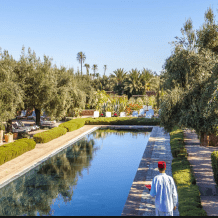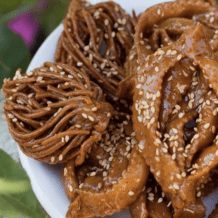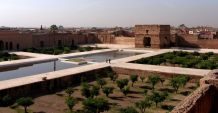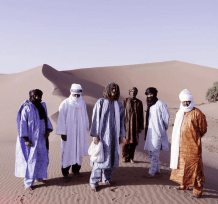
At the small town of El Kelaa M’Gouna (also referred to as the Valley of Roses) in the aSouth of Morocco, a 140km East of Ouarzazate, in the heart of Dades Valley one can see the manual harvest of Damas roses and the Rose Festival in May each year.
There is a thriving local industry distilling rose water, introduced by the French in the 1930’s and cosmetic products such as soaps, gels, creams, sprays and oils and dried rosebuds these can be bought on site.The buds are dried for use in cosmetics, home decoration and cooking, while the petals are distilled into rose water and, ultimately, rose oil, a key ingredient in many perfumes. Distillation is made in two factories in the Valley of Roses area and in April and May it is possible to visit Kelaâ’s factory, set up in a former kasbah.In Kelaâ Des Mgouna , Morocco there is also a dagger factory, in the mellah, where the Jewish craft is perpetuated, with handles and sheaths made in cedar wood or in camel bones, ornate with silver, and fixed on blades coming from another small village a few kilometres away.

The distillation plants work with 3,000-4,000 tonnes of petals a year. With ten tons of petals required to produce a few liters of precious oil, the harvest is extensive culminating in the annual Rose Festival each year in May when El Kelaa MGouna becomes a colourful centre of berber dancing and music with stalls of local crafts and products for sale. A festival queen is chosen from a parade of brightly coloured floats which is a highlight of the event.
Driving across the desert from Ouarzazate you come across El Kelaa MGouna and shortly afterwards you arrive at the Valley of the Roses.The greenryof the M’Goun wadi, is a sharp contrast to the desert scenery on the way from Ouarzazate.The river is hidden by a dense patchwork of palms, olive and fig trees, pink roses and swathes of red poppies. The turrets of kasbahs in a remote village cn be seen with the snow-capped Atlas Mountains in the background.Also well worth a visit is nearby Skoura which has old kasbahs and mellahs with impressive gardens.
The fresh mountain air has a hint of fresh roses which provides opportunities for walks and hiking and a long drive through the Hdida Valley to the plateau of Imi-n-Louh. There are a number of ruined kasbahs to explore and many opportunities to meet the local communities. The Damascene roses were said to have been introduced into the valleyin the tenth century by Morocans returning from Mecca.They grow in profusion in pinks and reds throughout the valley and in the hedgrows. In the Spring you can buy a garland of roses from one of the local children who line the route.

The Dades Gorge in the valley of the roses and the Todra Gorge provide some of the most spectacular scenery in the south of Morocco. The Dades Gorge runs along the Dades River valley separating the Atlas Mountains from the Anti Atlas. The Gorge is best known for its scenary stunning scenery and the Kasbahs overlooking the river below.
Gravity defying rock stacks in all shades of red dominate the skyline with deep gullies created by the persistent action of weathering and the river. After exploring the gorge, if you have a guide who knows the area it is possibble to venture deeper into the surrounding country side of the Anti Atlas. Some of the piste roads that lead off this are spectacular and properly remote and well worth taking a little more time to explore either by 4×4 or using a private tented camp as a base for exploring on foot.Continuing west brings the traveller Erfoud, a small town that for many acts as the entry point for Morocco’s western desert, the Erg Chebi. The dunes in this region are the main attraction and well worth visiting and climbing and Merzouga is close by.
For More Information About Morocco’s Rose Festival and Tours


